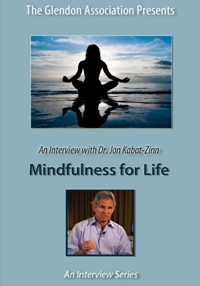Mindfulness – The Nitty Gritty of Attunement
Watch and read our exclusive interview with Jon Kabat-Zinn.
Another metaphor for it would be even the greatest orchestras, they don’t start playing Mozart and Beethoven even though they’ve got the greatest musicians, the greatest instruments. First, they tune. First, they tune. And they took a long time to tune to themselves and then they tune to each other. So, you could think of mindfulness as a form of attunement. You’re attuning to the breath, to a sense of the body as a whole, sitting and breathing with a myriad universe of sensations inside the envelope of the body.
Then, there’s like, what’s going on in the mind – thoughts, emotions, concepts, images and a lot of it’s about like, “Well, what am I supposed to be feeling here? Is this all I’m – I’m not feeling anything.” It’s just, it’s just, you know, an endless stream of thought. It’s not like you’re trying to shut off your thoughts. That will just give you a gigantic headache. But a lot of people think that’s what meditation is – just make my mind blank — I’ll be so free. My mind will be blank. Of course, those are all thoughts and you’re not going to get rid of them. But if you try, as I said, you’ll give yourself a big headache. You’ll also think, “This is the stupidest thing I’ve ever done in my life.” And you’ll abandon it.
Because it’s hard work to befriend yourself, to actually drop in on yourself and visit for awhile, in awareness, without doing anything. So, that’s what – and then, but the real meditation practice isn’t this. In other words, it’s not lying on the floor and doing a body scan, although that’s lying down meditation, incredibly important. The real meditation is how you live your life from moment to moment. How you live your life from moment to moment. It’s all relational. So, when you tune in to the body or the breath or sounds or smells or taste or touch or, or awareness of awareness itself or awareness of thoughts and emotions, when you tune in in this way, it’s a kind of relationship. Awareness and the objects of awareness. Our attention and the objects of your attention. OK? But it’s not separate. There’s actually not a “you observing” and then everything that’s being observed. That’s kind of a figment of our, the way the brain works.
But what we’re actually experiencing in meditation, or at least it’s possible to experience, a kind of unification, where it’s no longer me sitting, it’s just sitting and awareness. And if you ask, “Well, who’s sitting?” or “Whose body is it anyway?” you know, because we’ll say, “Mine. It’s my body. It’s my breath. It’s my life. It’s my thoughts. It’s my pain. It’s my stress.” But who is that claiming it all? And when you investigate and you put the welcome mat out and you turn towards what you most don’t want to even deal with and you don’t try to deal with it merely through thought, but we’re not, we’re not pushing thought away – we’re simply embracing something much larger than thought, but inclusive of thought, then you begin to realize that whatever the construct of our ideas about who we are, it’s really diminished. It’s much smaller than who we actually are.
Order the Full DVD Interview:
 Mindfulness for Life: An Interview with Jon Kabat-Zinn
Mindfulness for Life: An Interview with Jon Kabat-Zinn
In this DVD, Dr. Jon Kabat-Zinn defines mindfulness as a way of “connecting to your life.” He discusses the “hard work” of living in the present moment, the personal and psychological impacts of developing a practice of mindfulness, and the benefits of utilizing mindfulness in therapy. He also touches upon mindfulness in parenting. Drawing upon his years of experience and research in the field of mindfulness, Dr. Kabat-Zinn offers an inspiring and instructive approach for mental health professionals and curious individuals alike.
Tags: attunement, jon kabat-zinn, mindfulness, mindfulness meditation, stress depression









Leave a Reply